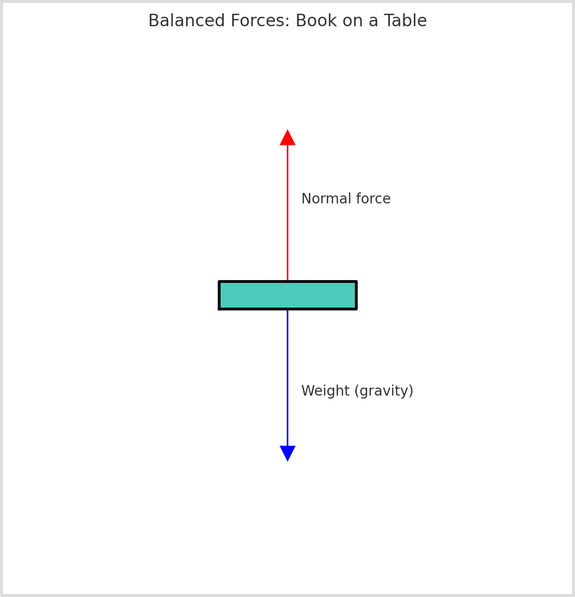The definition of "force" is the push or pull on an object that causes it to move, stop, or change shape. There are two types of force between two objects: contact and non-contact. Objects need to be in contact for a contact force. Examples of contact forces include your foot kicking a football or the friction between your shoes and the ground. Non-contact forces act over a distance, without physical contact. For example, magnets pushing/pulling together, or gravity keeping us from floating into space.
These forces in science explain the daily occurrences we see all around us. We will explore both types of forces in this article, including the difference between contact and non-contact forces, and give numerous examples of each. Quiz questions are included to test your knowledge.
If you need further help, TeachTutti has qualified GCSE Physics tutors. Lessons can be in-person or online, and tutors will tailor lessons to your specific needs.
Contact Forces
Contact forces happen when two objects touch or interact with each other. These forces are easy to spot in the world around us, such as kicking a ball, writing with a pen, or opening a door. The force exerted is created through direct contact.
There are four types of contact forces you're expected to know for GCSE Physics:
- Friction - This force acts opposite to motion, as it resists movement between surfaces. Compare sliding across ice to sliding across concrete: the difference is due to friction.
- Air resistance - This acts against moving objects travelling through the air, such as the wind resistance you feel cycling, or how effectively a parachute slows down a skydiver. Air resistance is also an example of a frictional force because it slows objects as they fall.
- Tension - This is a pulling force that acts along the length of a flexible connector. The tension force is passed through the object when opposing forces or energy are applied in opposite directions, trying to pull it apart, e.g. when you pull on a rope or cable. Tension is what happens when you tow a car.
- Normal contact force - This acts perpendicular (at a right angle) to any surface that supports an object. It prevents objects from passing through each other. For instance, a shelf holding books or a chair supporting your body.
Examples of Contact Forces
We have given a few examples below of the forces that act between two objects that are physically touching. These are daily occurrences that you'll encounter regularly:
Kicking a football - When you kick a football with your foot, you transfer energy through direct contact that propels the ball forward.

Rubbing your hands - If you rub your hands together briskly, you'll feel heat generated by the friction between your palms. This is comparable to starting a fire with two sticks.
Pulling a suitcase - Tension is created in the suitcase handle when you exert a pulling force from your hand to the suitcase wheels.
Sitting on a Chair - The chair supports your weight with a normal contact force. This pushes upwards and balances the downward pull of gravity on your body.

1
What is not a contact force?
Non-Contact Forces
Non-contact forces don't need direct physical touch. They influence objects over distances, such as by using the electromagnetic field. You can't see these invisible fields, but their effects are evident in the world around us. A non-contact force is also called a field force.
We have explored three non-contact forces you are expected to know for GCSE Physics.
Gravitational force
Gravity is the reason objects fall towards Earth when they are dropped. Every object that has mass generates gravitational attraction. This is strongest with the largest masses, such as planets or stars. It also pulls planets together in the solar system. For example:
- The Moon orbits the Earth due to gravity. The gravitational pull of the Earth keeps the moon moving around the planet, rather than drifting into space.
- The Earth and other planets in our solar system orbit the sun. This causes tides as the Moon's gravity pulls on Earth's oceans.
Magnetic force
Magnetic forces act between magnets and also between magnets and certain metals, such as iron and steel. When a charged particle moves inside a magnetic field, it creates a magnetic force.
For example:
- The magnets stick to your fridge due to magnetic attraction. You can feel this force if you hold two magnets close together - you will feel their push (repulsion) or pull (attraction).
- A compass needle always points true north (towards the North Pole) due to the Earth's magnetic field.
Electrostatic force
Electrical charges cause electrostatic forces. Like charges repel, meaning positive-positive or negative-negative. Opposite charges attract each other, meaning positive-negative. For instance:
- Rub a balloon against your hair - The balloon picks up electrons, which creates a static charge. The balloon will now stick to a wall because the charges attract.
- Lightning - When there is a storm, the lightning is the electrostatic force. It is caused by a massive charge difference between the clouds and the ground.
Non-contact forces are crucial to our world. Gravity holds planets in orbit, magnetism enables technologies like electric motors, while electrostatic forces are used in static electricity, and we experience them vividly in thunderstorms.
Examples of Non-Contact Forces
Apple Falling from a Tree | Gravity - When an apple falls from a tree, it will drop straight to the ground. This is due to the Earth's gravitational pull. It is also how Isaac Newton is believed to have discovered gravity.

Compass pointing North | Magnetism - The needle of a compass will always point true north. This is because it aligns with Earth's magnetic field.
Balloon sticking to a wall | Electrostatic - A balloon becomes charged with static electricity when you rub it on your hair. This lets it stick on a neutral surface like a wall, due to electrostatic attraction.
Lightning | Electrostatic - Lightning is caused by the buildup of static electricity in clouds. This discharges in powerful electrical sparks to the ground, otherwise known as lightning.

2
What is an example of a non-contact force?
Force diagrams and vectors
A force diagram shows us the force acting on an object. They are also known as "free body diagrams". They help us to analyse forces and understand motion. The object is usually shown by a dot or a small box, while vectors (arrows) show the forces, including their size and the direction that they act.
Below are the key details of a force diagram:
- Vector length - A vector is an arrow. A longer arrow means the force is greater.
- Arrow direction - The direction of the arrow tells us which way the force is acting.
- Balanced forces - Forces are balanced if they're equal and opposite. This means there is no movement or constant speed.
- Unbalanced forces - When forces are unbalanced, it means one force is greater than the other. This results in movement or acceleration.
For example, let's say a book is lying still on a table. Two balanced forces are acting on the object. Gravity causes the weight of the book to push down on the table, towards the ground. Meanwhile, the normal contact force from the table pushes upwards against the downward force. The arrows in the diagram will be equal in size, but opposite in direction.

Another example is the game of tug-of-war. If one team pulls harder, it will lead to a greater pulling force. This means movement will go towards the stronger side. A tug-of-war is a good example of unbalanced forces:

3
What are balanced forces?
Final thoughts | Contact and non-contact forces - GCSE Physics
Understanding the difference between contact forces and non-contact forces is an important aspect of GCSE Physics. Contact forces always need interaction between objects, such as friction, air resistance, tension and normal force. Non-contact forces can act over distances and don't need to touch due to using invisible fields. Examples include gravity, magnetism and electrostatics.
You will be expected to recognise these two forces and draw accurate force diagrams in your examinations. To help you understand, go on a walk and look for as many examples of these forces as you can. You will be surprised how many you see!
For further reading, you can read NASA's guide to Newton's Laws of Motion, which explains the physics behind how and why objects move when forces act. You can also test yourself on contact and non-contact forces questions by BBC Bitesize.
If you need support revising this topic, TeachTutti have dedicated GCSE Physics tutors. Every tutor has an enhanced DBS check and will tailor lessons to your specific needs, such as preparing revision notes.

